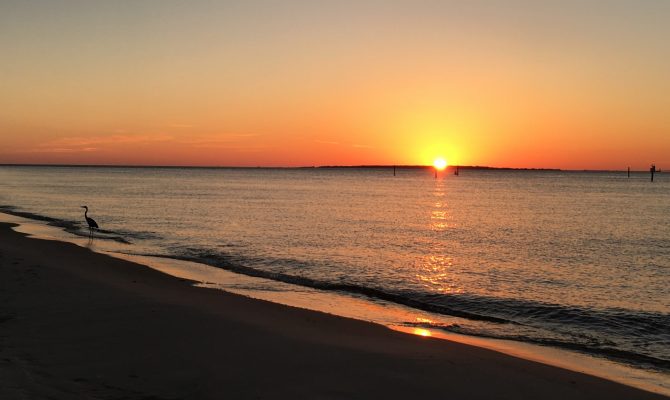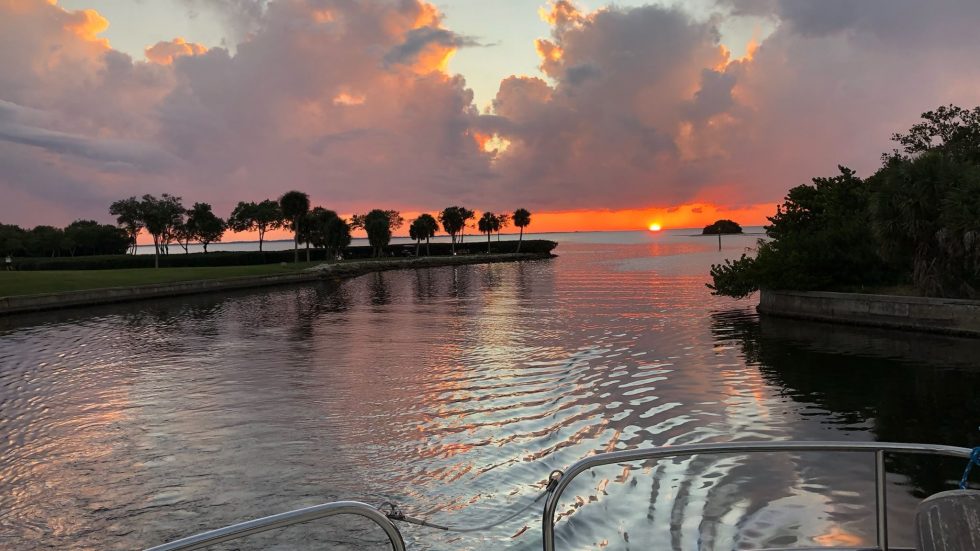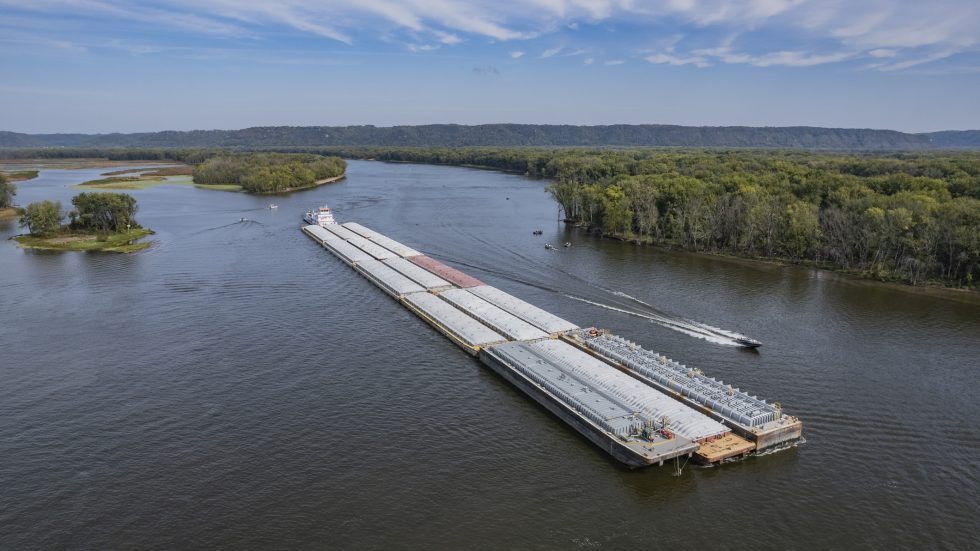Recently on a trip to Florida, my son and I stopped by to visit old friends we met in Canada years ago while our families were doing the Great Loop. The last time we had seen each other, we were celebrating our successful arrival in Florida after traveling down the inland rivers and waterways from Lake Michigan. As we joyously recalled the most memorable moments of our trip, it became obvious our Great Loop adventure had been a life-changing experience. Each of our families had taken a year off from work and school to do the Loop — not an easy decision for either family. But we all agreed it was one of the best decisions we had ever made.
Since that time, I’ve retraced many parts of the Great Loop on a number of different boats. This six-part story is a compilation of these experiences, and it begins in Pensacola, Fla., where we have arrived after a two-month journey south from Chicago. We welcome the sight of aqua blue water and white sandy beaches after navigating 1,300 miles of rivers, locks and waterways — a trip that at times can be more work than play because of extreme water levels, storm debris, lock delays, limited fuel and marina facilities, and heavy commercial traffic. The challenges, of course, make doing the Loop such an exciting adventure.
The Sunshine State
As we enter Pensacola’s Palafox Pier Marina, we spot a number of fellow Loopers identified by their America’s Great Loop Cruisers’ Association (AGLCA) burgee. It’s not uncommon to find clusters of Loopers at key stopovers, and we are happy to spot friends we last saw in Demopolis, Ala. Two other families join us on board to compare our experiences traveling down the Tennessee-Tombigbee (Tenn-Tom) Waterway. We also share plans and review our charts for our next leg, which will take us along Florida’s Panhandle to Apalachicola and then across the Gulf of Mexico to Clearwater.
Pensacola has a rich history dating back to the 16th century, and over the years it changed hands more than a dozen times. Today, it remains a major Navy town and is home to the National Museum of Naval Aviation as well as the Blue Angels. A walk along the waterfront, and nearby Main Street reveals a southern town that has not lost its charm in spite of economic hard times.
The Gulf Intracoastal Waterway (GIWW) provides a protected, attractive route along the Panhandle from Pensacola (Mile 185) to Carrabelle (Mile 380), so we stay inside for the 90-mile trip to Panama City. This stretch of waterway passes between the mainland and a series of beautiful barrier islands that are mostly undeveloped. While we are enjoying the change of scenery from our two-month river trip, we now have the extra chore of keeping our boat clean in the saltwater environment. We also note a slight improvement in our boat’s cruising speed, as the saltwater’s higher density provides a bit of extra prop bite.
Our slip at the Panama City Marina is convenient to downtown — a lively, vibrant collection of restaurants, shops, art galleries and offices. There is also a large charter fishing fleet based here, and it appears the local sportfishing industry is finally recovering from the BP oil spill. The next day, we continue on the GIWW for 60 miles to Apalachicola (Mile 350), one of our favorite Florida towns. As we pass the small village of White City at Mile 329, we remember to reset our clocks to Eastern Standard Time.
There is something about Apalachicola that has drawn us back year after year. Maybe it’s the laid-back locals or the down-to-earth stores and restaurants. Or maybe it’s simply the famous Apalachicola oysters served at Papa Joe’s Bar. Located in the heart of Florida’s Forgotten Coast, it remains an unvarnished waterman’s town. Yet it has attracted new residents with the resources to restore its historical homes and commercial waterfront.
We tie up at the Water Street Hotel and Marina and walk into town to meet our friend, Marc Grove, who runs Wefing’s Marine, the local dealer for Ranger Tugs and C-Dory. These are great, economical boats for doing the Loop, and Marc is busier than ever.
We next stop at Carrabelle for fuel and wait for a good weather report before venturing out into the Gulf of Mexico. While many Loopers make the 150-mile offshore passage from Carrabelle to Tarpon Springs, we elect to follow the coastline to explore Florida’s Big Bend. During the next two weeks we explore the fascinating but skinny waters of the Steinhatchee and Withlacoochee Rivers visiting the remote towns of Steinhatchee and Yankeetown.
Continuing down the Big Bend, we play hide and seek with scores of manatees attracted to the natural springs of the Crystal River. Nature lovers and wildlife photographers love this unspoiled territory, but boating here requires extra caution because of the shallow waters. Even miles offshore, depths in this part of the Gulf of Mexico can dip below six feet.
Returning to civilization in Clearwater, we begin to plan our trip down the west coast of Florida, which is much more populated and developed than the Panhandle or Big Bend. Before making our decision of whether to cut across the Okeechobee Waterway at Ft. Myers or to work our way further south to the Keys, we’ll spend 10 days cruising the beautiful waters of Charlotte Harbor and the barrier islands of Sanibel, Captiva and Cayo Costa. This is a cruiser’s paradise with protected anchorages, pristine beaches, public parks with walking trails and resort-like marinas. We never miss a chance to have a Фcheeseburger in paradise‘ at the Cabbage Key Inn, where the walls and ceiling are lined with dollar bills.
A Choice of Routes
From Ft. Myers, Loopers can turn east and head across the Okeechobee Waterway, a fascinating 135-mile trip through the rural interior of Florida ending in Stuart. Depending on rainfall, controlling depth can be an issue for boats with drafts exceeding five feet, so it’s a good idea to check with the local Army Corps of Engineers (863-983-8101) before proceeding. With five locks and 20 bridges to negotiate, and spectacular backwater scenery to enjoy, one should allow at least two days to make the trip. Clewiston (Mile 76) and La Belle (Mile 103) are popular stopovers and are good reasons to spend even more time exploring this waterway.
The alternative Great Loop route is to continue down the west coast from Ft. Myers to the Keys, a distance of 250 miles. Heading south past Marco Island, it’s necessary to stay at least three miles offshore of Cape Romano to avoid the shoals before reaching the Ten Thousand Islands and the waters of Everglades National Park. These remote, uninhabited islands feature white sandy beaches and thick mangroves and are best explored by kayak or shoal draft boats. Like the rivers of the Big Bend, they attract wildlife photographers and nature lovers from all over. One of the area’s highlights is the small village of Everglades City and its famous Rod & Gun Club, where past presidents and celebrities came to hunt and party.
Continuing south down Florida Bay we arrive in Marathon, which we’ll use as a base for exploring the Keys. Key West, known for its zany locals, street performers, infinite number of bars and great food is a must-see. Islamorada, known for its fishing and friendly Plantation Yacht Harbor located in Founder’s Park, is a perfect place to unwind and enjoy the backcountry waters. Further north, Key Largo begins to resemble the more populated parts of Florida. We stop here for a couple of days and run out to nearby John Pennekamp Coral Reef State Park for some spectacular snorkeling.
As we leave the Keys behind and approach Miami via Biscayne Bay, we know our trip up Florida’s East Coast will be very different from our exploration of the West Coast. After spending a couple days in Miami’s South Beach enjoying the Art Deco District and high energy of the bars and restaurants along Ocean Drive, we make our way up the Intracoastal Waterway (ICW) with stops in West Palm Beach, Vero Beach, Melbourne, New Smyrna Beach, Daytona Beach, St. Augustine and finally Fernandina Beach. We take our time along the ICW, preferring the protection of this inland waterway to the offshore run. From Miami to Fernandina Beach, we log nearly 400 miles during a 10-day period. St. Augustine and Fernandina Beach are our favorite stops, as each has its own charming flavor and rich history.
This eight-week, 1,200-mile journey from one end of Florida to the other can serve as an ideal learning experience for beginning Loopers, especially those without a lot of open, saltwater experience. Learning to deal with tide fluctuations, narrow channels, quick moving storm fronts, unmarked shoals and heavy commercial traffic will be good preparation for things to come.
For boaters of all levels of experience, Florida’s beautiful waterways and combination of backcountry wildlife and big city attractions make this leg of the Great Loop a perennial favorite. Join us in the next issue as we head up the ICW and spend weeks exploring the wonderfully vast, cruiser-friendly Chesapeake Bay.
Rendezvous in View
What could be better than spending a beautiful day in May surrounded by the exciting and historic waterfront city of Norfolk, Va., attending educational seminars, socializing with fellow Loopers and enjoying excellent cuisine? How about spending four beautiful days?
AGLCA’s Spring Rendezvous & Reunion is scheduled for May 5-8 at the gorgeous Sheraton Norfolk Waterside. The Sheraton has become a member favorite over the past three years, and it’s easy to see why: The breathtaking waterfront views, friendly staff, delicious food and plentiful amenities make this the perfect spot to usher in the spring boating season.
Members consistently give these events top ratings. According to the group’s recent attendee’s survey, last year’s Norfolk Rendezvous received a 4.6 rating out of 5! Some of the most popular seminars include:
-
- Everything You Want to Know About Yacht Insurance
-
- Conquering Those Locks
-
- The ABCs of Looping
-
- Cruising Lake Michigan
These events are for AGLCA members only so, if you are not yet a member, join now and take advantage of one of the most valuable benefits of belonging! To join, go to www.greatloop.org and click on the “Join Now!” tab.
If you are already a member but not yet registered, visit the “Ship’s Store” on the Great Loop website and go to “Rendezvous & Events.” From there, you can register and reserve your accommodations.





